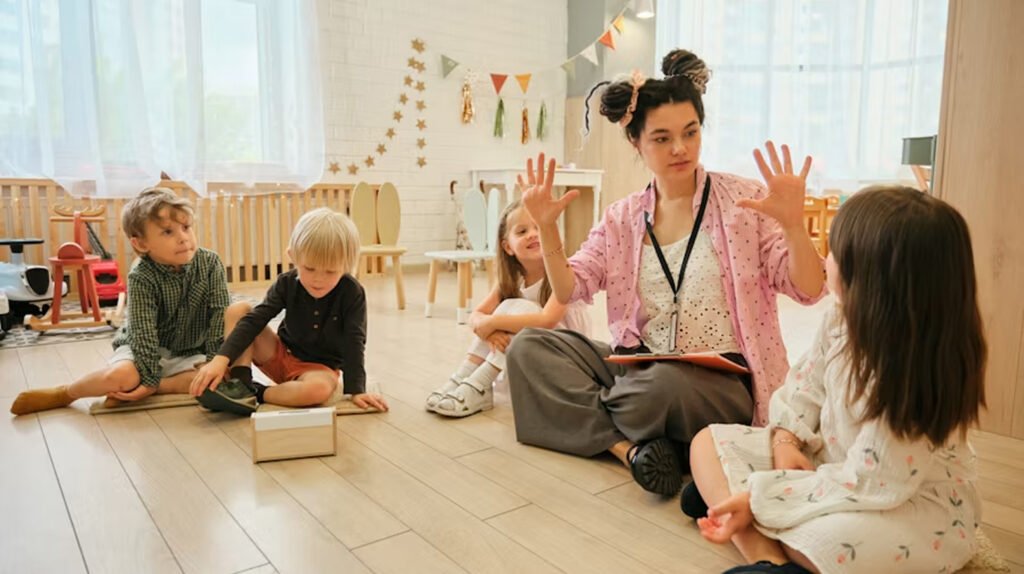“How have you successfully incorporated mindfulness or stress-reduction techniques into pediatric care? What’s one method that children respond to particularly well?”
Guided visualization through storytelling
Incorporating mindfulness techniques, such as guided visualization through storytelling, into pediatric care can significantly improve children’s emotional well-being and health. This method involves leading children through calming narratives, helping them escape distressing thoughts and manage anxiety, especially in medical settings. Children respond positively to storytelling, as it engages their creativity and imagination, making it an effective tool for reducing stress.
Mohammed Kamal, Business Development Manager, Olavivo
“Bubble breathing” or “Balloon belly breathing.”
One particularly successful way mindfulness has been incorporated into pediatric care is through the use of guided breathing exercises framed as play — often referred to as “bubble breathing” or “balloon belly breathing.”
One Method Children Respond to Especially Well: Bubble Breathing
What it is:
Children are asked to imagine they are slowly blowing bubbles or inflating a balloon in their belly. This turns deep breathing into a visual and imaginative experience rather than a clinical one.
How it works:
Inhale slowly through the nose, imagining a balloon expanding in the tummy.
Exhale gently through the mouth, as if blowing a bubble without popping it.
Often paired with a physical prop (real bubbles or a toy balloon), or visuals on a tablet or flashcards.
Why It Works:
Engages the imagination, which is key in pediatric settings.
Activates the parasympathetic nervous system, reducing anxiety and heart rate.
Helps children regulate emotions during medical procedures, therapy, or transitions (e.g., pre-surgery, shots, hospital stays).
Can be done anywhere — in clinic rooms, classrooms, or at home with parents.
Broader Benefits in Pediatric Care:
Improves cooperation during treatments or check-ups.
Builds emotional resilience and self-awareness from a young age.
Often strengthens child-parent communication, especially when parents are taught to co-practice with their child.
Marc Bromhall, Founder, Dentist Hub
Deep belly breathing combined with visual cues
Incorporating mindfulness techniques into paediatric care has shown measurable benefits in managing anxiety, enhancing focus, and improving emotional regulation in children. One method I’ve found particularly effective in clinical practice is deep belly breathing combined with visual cues.
Why It Works Medically
Children’s autonomic nervous systems respond well to regulated breathing. Deep diaphragmatic breathing activates the parasympathetic system, reducing cortisol levels and promoting a sense of calm. Unlike abstract mindfulness exercises, breathing techniques are tangible, non-invasive, and accessible even to young children.
Implementation in Practice
To make the technique relatable, I often use imagery such as “blowing up a balloon” or “smelling a flower and blowing out a candle.” This helps engage younger patients without overwhelming them. We typically:
Guide the child to place one hand on their belly and another on the chest.
Ask the child to take a slow breath in through the nose for a count of four, imagining they’re gently sniffing a flower, and feel their belly expand like a balloon.
Exhale slowly through the mouth for six seconds (“blow out the candle”), watching the belly fall.
Repeat for 3-5 cycles, turning it into a mini-game or using visual timers or apps if needed.
This approach not only helps in the clinic but equips families with a simple tool they can use during stressful moments at home or school. Over time, consistent use has led to noticeable improvements in children with anxiety, attention issues, and even sleep disturbances.
Dr Sankeerth Yellinedi, Neonatologist and Paediatrician, Marwellus Clinic & Diagnostics
Guided imagery and deep breathing
Incorporating mindfulness and stress-reduction techniques into pediatric care is vital for enhancing children’s well-being. As a marketing director, promoting practices like guided imagery and deep breathing can benefit healthcare partners and appeal to caregivers seeking holistic solutions for their children. These techniques effectively lower stress and anxiety levels, making them suitable for medical settings.
Michael Kazula, Director of Marketing, Olavivo
Guided breathing
Mindfulness is integrated into every one of my patient interactions in the office. Kids come in with fear, fear of the pain, new equipment, or just being somewhere strange. I confront that directly with easy, repeatable skills that assist them in relaxing and feeling empowered.
One technique that applies to all ages is guided breathing. I instruct children to slowly breathe in through the nose and out through the mouth. For preschoolers, I call it “pretending to blow a big bubble.” They get it right away, and the process of concentrating on breathing gives them control of their feelings. We do it before any procedure. It only takes less than a minute and brings about a definite change in behavior.
For kids with sensory sensitivities, we utilize low-stimulation rooms, noise-canceling headphones, and visual storyboards describing what is going to occur step by step. Some are helped by weighted blankets over their laps. Others are helped by brief mindfulness stories with visual aids to anchor them. These accommodations decrease stress without the necessity of sedation or additional interventions.
This method doesn’t slow things down; it makes every step smoother. When children feel safe, they cooperate. When they know what’s going on, they relax. And when they trust the setting, they return without fear. Mindfulness isn’t an extra. It’s how you make dental care work for the child, the parent, and the provider.
Dr. Jasveen Singh, Pediatric Dentist & Owner, Pediatric Dentistry And Beyond
Guided imagery
Incorporating mindfulness into pediatric care has been a game-changer for managing anxiety and stress in children. One technique that’s particularly effective is guided imagery. I’ve used it with younger patients, especially those who are nervous about procedures. I guide them through a calming mental journey—like imagining they’re at the beach or in a favorite place—while we do something routine like taking vitals. This technique helps distract them from the medical setting and reduces their anxiety.
It also empowers them by giving them a sense of control over their experience. Over time, I’ve found that children respond really well to these calming exercises, and they often ask for them during follow-up visits. Mindfulness practices like this can make a real difference in how children perceive healthcare, transforming it from a stressful experience into something more manageable.
Nikita Sherbina, Co-Founder & CEO, AIScreen
Guided breathing paired with visual storytelling
In pediatric dental care, creating a calm, reassuring environment is just as important as providing clinical excellence. Children often experience dental anxiety, so we’ve intentionally integrated mindfulness and stress-reduction techniques into our approach—especially during their initial visits and more complex procedures.
One method that children respond to particularly well is guided breathing paired with visual storytelling. Before beginning treatment, we invite young patients to choose from a set of calming, illustrated story cards—imaginative scenes like “floating on a cloud,” “exploring an underwater world,” or “riding a gentle balloon ride.” We then guide them through a brief, age-appropriate breathing exercise that aligns with the theme: “Let’s take slow balloon breaths so we can float gently up to the sky.”
This simple but effective technique helps children slow their heart rate, shift their focus away from fear, and feel more in control of the situation. It’s both a grounding and imaginative activity, and it encourages cooperative behavior while building trust.
In the background, we also maintain a sensory-friendly environment—soothing lighting, soft instrumental music, and a gentle, unrushed tone in our communication—all of which support stress reduction. When children feel seen, heard, and empowered through these small but intentional mindfulness techniques, their experience transforms from fearful to positive.
Mindfulness isn’t just about calming kids in the chair; it’s about helping them develop emotional resilience in dental settings. Over time, many of our young patients look forward to their visits—not just for the prize at the end, but because they feel safe and understood.
Quyen Dang, Dentist, Optimal Dental Center
Incorporating mindfulness into pediatric care is all about meeting kids where they are—playful, curious, and embodied. One method I’ve found especially effective is teaching “bubble breathing.” I’ll tell children to imagine they’re blowing a giant bubble with their breath—slow inhale through the nose, then exhale gently through pursed lips like they’re inflating a bubble wand. It turns breathwork into a game, and suddenly, regulating their nervous system feels fun instead of clinical.
Children may not always have the language to express stress, but their bodies feel it. By integrating mindfulness into moments they already enjoy—drawing, movement, storytelling—we help build emotional awareness and resilience early on. The key is making it experiential, not instructional. When kids learn that their breath can change how they feel, it plants the seed for lifelong emotional regulation.
Dr. Sam Zand, CEO/FOUNDER, Anywhere Clinic
Guided storytelling
At Ridgeline Recovery, we don’t specialize in pediatrics—but we do work closely with families, and that includes kids who are impacted when a parent enters treatment. That exposure forced us to get real about stress reduction—not just for adults, but for the children caught in the chaos.
One approach that’s consistently made an impact: grounding through guided storytelling. Not just any story—personalized ones built around the child’s world. We use short, sensory-based scripts with familiar elements: their pet’s name, their favorite color, their safe space. While it sounds simple, this gives them a place to anchor when their real-world stability is gone.
What makes this work? It’s not therapy disguised as play. It’s play done with purpose. Kids respond to imagination when they feel out of control. And when you bring a parent into that moment—even if they’re just reading the story over a Zoom call from residential—something shifts. That shared experience becomes a form of repair.
We also avoid clinical language around kids entirely. No one wants to hear, “Let’s regulate your nervous system.” But they’ll gladly “practice dragon breathing” if it means blowing out like a fire-breathing lizard. The key is translation. You’re not just calming the child—you’re helping the parent re-learn connection. That’s real healing.
Bottom line: mindfulness with children isn’t about sitting still and being quiet. It’s about giving them a thread to hold onto when their world’s been turned upside down. That thread might be a silly story or a breathing game—but if it lowers their guard and reminds them they’re safe, then it’s doing its job.
You don’t need fancy techniques—just presence, intention, and a willingness to meet the child where they are.
Andy Danec, Owner, Ridgeline Recovery LLC

